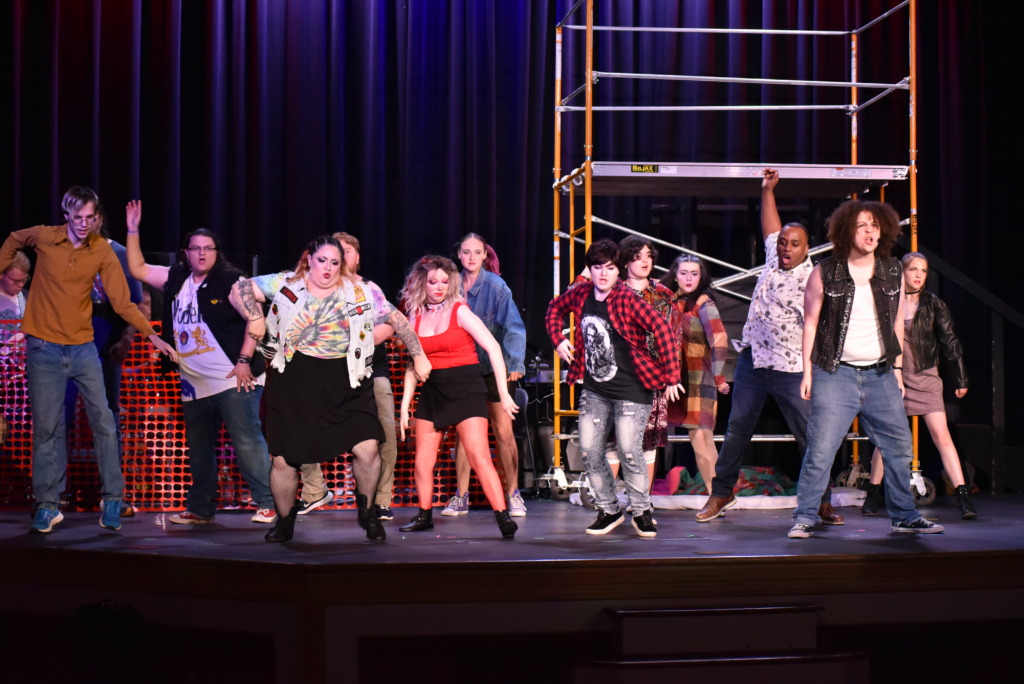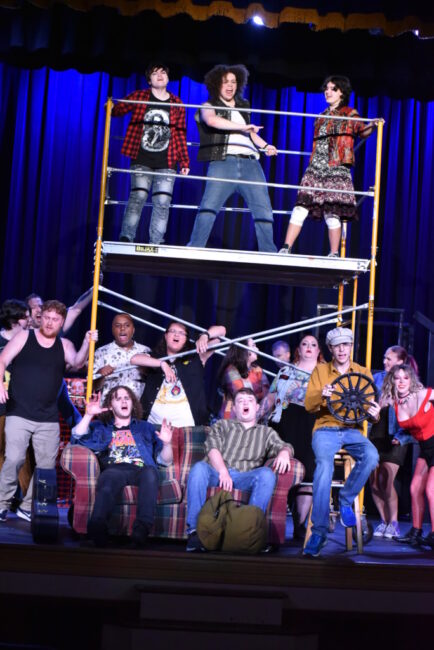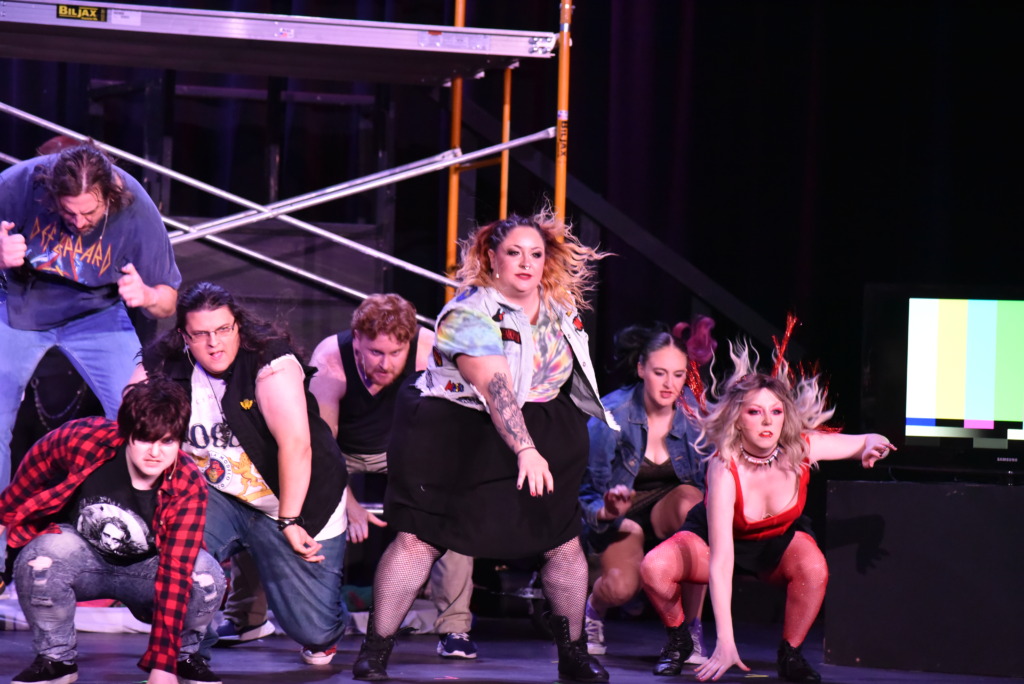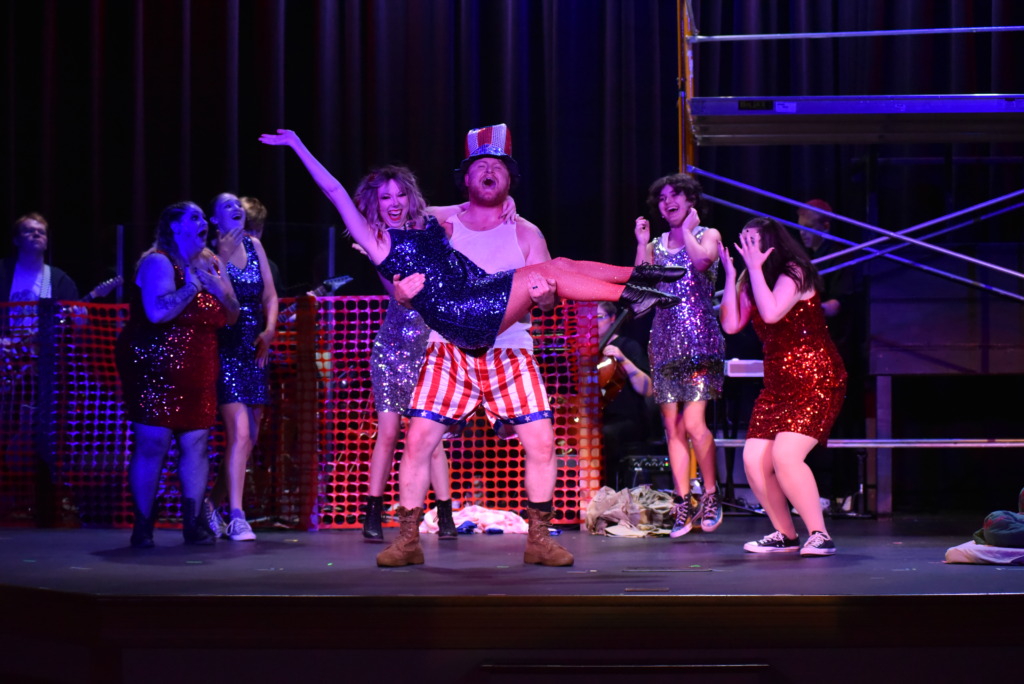author: Amanda N. Gunther
They’ve taken the photographs and still-frames in their mind and hung them on a shelf— well, a stage— in good health and good times… Small Town Stars Theatre Company is putting tattoos of memories and dead skin on trial with their striking and impressive production of Green Day’s American Idiot. Directed by Miranda Secula-Rosell (with Assistant Director Erik Secula) with Vocal Direction by Jude Sims, and Choreography by Delaney Goodwin & Abigail Weinel, this edgy concept-album-come-rock-opera is truly a passion project that will strike hard chords of nostalgia for anyone who remembers the album’s release back in ’04 and will tell a fascinating tale for anyone unfamiliar with the source material.

It takes a village, as anyone who has ever worked in community theatre knows, and the village that Small Town Stars Theatre Company has gathered to assemble and produce Green Day’s American Idiot is a strong one; there’s a deep bench of talent on the stage and an even deeper one working behind the scenes to get all the fine details of set, costumes, concepts, lighting, etc., in place. This is by far one of the most impressive productions I’ve seen to-date at Small Town Stars, and it’s wildly engaging; you can feel the passion of this project from all angles.
The set is simple and yet highly effective; designed and constructed by Tim Beavers and Paul Keays, there’s a rolling-scaffolding structure, which serves multiple purposes throughout, some orange-plastic-net-fencing to rope off the band, a bank of TV screens (house right/stage left) a roll-on couch that is the perfect flavor of fugly-hideous, and a few other roll-on scenery beds and pieces. And that’s it. And it works delightfully for this production. Beavers and Keays turn the rolling scaffolding into a double-decker transit bus for “On Holiday” and the visual effect is striking. The entire production is filled with little visual moments that stab you in the gut or take your breath away… or stab you in the gut and take your breath away; it’s quite a visionary show. And Director Miranda Secula-Rosell (assisted by Erik Secula) really hones in on a lot of these moments that augment the narrative behind the concept album; the connectivity of emotions to visual representation is tremendous in this production.

The costumes, for the most part, feel on point. Grungy, rocker early 00’s-inspired (though in a few cases, it does feel a bit like the younger generation’s interpretation of that era of fashion as opposed to what those of us who were in high school and college during that time actually remember) but it works with the overall vibe of the show. Secula-Rosell doubles up as the show’s costume designer and she hits the nail on the head when it comes to some of the more outrageous featured fashions, like the red, white, and blue sequin glimmer gowns for the gals in “Favorite Son” or the overall couture featured on St. Jimmy.
One of the most impressive features of this production in the sound balance, by way of Sound Designer Dagny Beavers. Having a live band on stage is always challenge, particularly at the community level. You can see the band (who are dressed in those black button-downs with long, shiny red ties, just like Green Day!), with the orange-plastic-construction-lattice-fencing guarding them off from the main play-space, but they never overpower the performers. It’s a delicate, meticulous balance, one that Beavers has mastered for this production and it’s completely praiseworthy. Having the live orchestra (featuring Bill Dixon on bass, Arielle Baquol on cello, Jessica DeTello on viola, John Spence on guitar1, Kaleb Bauerlein on guitar2, Tom Spence on drums, Zakiyah Grayson on violin) is a real treat as it only adds to the lively nature of the production and helps to cover a couple of those scenic transitions where things fall ever-s0-slightly out of step. The orchestra has effortlessly captured the sounds of Green Day’s album and it just enhances the overall experience of American Idiot.
As the show’s Lighting Designer, Tim Beavers has a handle on how to get all of those patriotic pulses and flashes of red, white, and blue rolling at exactly the right moment. Beavers also has this “down-curtain” drop-lighting effect which creates the illusion of colors flowing down the back curtains during various numbers; it’s pretty wild. The lighting for this production almost becomes a background character of sorts, really pumping up the intensity of some of the more gripping musical numbers. Assistant Director Erik Secula adds to the show’s aesthetic with the use of various media clips and projection pieces over on the bank of TV screens; you can tell he’s done his research as each of the images, video footages, and mouthy messages that get flashed there fit the era to perfection. It’s a well-utilized concept and detail that just pulls the production tightly together.

Speaking of details, the work that Director Miranda Secula-Rosell has done to effectively put little moments on display is astonishing. There are a few I can call out (to praise) while others I don’t want to spoil— they’re quite impressive but would give away some really pertinent moments in the show. One of her finest choices in this production is casting Katie Ketter as St. Jimmy, a role more traditionally played by a male performer. As St. Jimmy is Johnny’s drug-addiction manifested in human form, you get this striking visual imagery every time Ketter’s character interacts with Johnny. It paints the picture that addiction can be perceived as fiendish mistress. When Whatsername and St. Jimmy are staged on the floor with Johnny caught between— it’s a harrowingly beautiful gut-punch of a moment, watching these two muses fight for his love and life. And the show is liberally peppered with visual moments like that— particularly when Tunny and Extraordinary Girl are featured together in the scene post “Extraordinary Girl.” One of the other truly astonishing moments is the way Secula-Rosell handles the show’s finale number, “Time of Your Life.” Again, can’t talk about it for fear of spoiling the wonder, but it’s ingenious and it really showcases the ensemble effort of this production by laying it out the way she does.
There are a few moments, like in “Extraordinary Girl” where some of the show’s choreography is a little clunky. Choreographers Delaney Goodwin and Abigail Weinel are just a little overly ambitious for that number— you can see what they’re going for— with the notion of ‘flying through dreams’ but the space they’re working in thwarts some of their more acrobatic endeavors (with the carries, lifts, ‘flies’, etc.) but that number aside, the show’s choreography is on-brand for the rock-opera-concept-album. There’s lots of foot-stomp-slamming, mosh-pit-movement, and angry-grunge-rocker-inspired routines, all of which are the perfect fit for the various and sundry musical numbers featured throughout the performance. Goodwin and Weinel do rise the challenge (aided by more than half-a-dozen dance captains in the ensemble) of making routines fit the play-space, which is somewhat restricted due to the scaffolding and the live band. But it works; it reads cleanly for the most part, and matches the energy of the rock numbers that its rolled through.

The cast, under the vocal direction of Jude Sims, brings powerhouse sounds to all of the big-group numbers, like the titular song, “On Holiday” and “St. Jimmy.” The harmonies are wild, the anger is real, and there is something truly intense happening with this performative ensemble. Featuring Jules Barrett, Dryden Beavers, C Szper, Rory Long, Mark McAlevey, Ryan Kimber, Sean Kimber, Darryl Warren, Paul Keays, Cara Wolf, Rebekah Chittenden, and Oliva Winter, the ensemble creates a nesting space or the seven ‘principal’ performers (I say that loosely because every ensemble member is given a name, a moment to shine, and several are featured in various duets as backing vocalists or harmonists) and gives them the support they need to thrive in this production. You’ll be dazzled by Olivia Winter, Rebekah Chittenden, Cara Wolf, C Szper, Elizabeth Vinson (Extraordinary Girl) and Cecelia Boynton (Heather) during “Favorite Son” as they shimmy and spin all around Paul Keays; the seven of them transform this number, which is pitched at Tunny in an attempt to get him to join the army. You’ll catch that same dynamic gathering of women during “Rock and Roll Girlfriend.” You won’t be able to take your eyes of Vinson when she’s in the ensemble; the intensity that girl is bringing to her dances and her overall stage presence is out of this world. And then you get powerhouse belters like Cara Wolf who provides an excellent ending for “Too Much Too Soon”, a song featuring her alongside Jules Barrett, Cecelia Boynton as Heather and the Will character.

As the ruffian St. Jimmy, Katie Ketter is really living up the chaos-demon that is this character. Vocally explosive, physically bombastic, and just a little all over the place (in the best way possible), particularly with her facial expressions during “The Death of St. Jimmy”, you get the sense that Ketter is wearing St. Jimmy like a second skin. And as mentioned, that moment when you see her opposite of Jordan Wheeler, playing Whatsername, you’ll find yourself truly struck by the blind-sided notion of what it represents. Wheeler, who plays almost coquettish and innocent in her meet cute with Johnny, has gorgeous vocals that get well-utilized in this production. The same too can be said for Cecelia Boynton as Heather, whose internalization of events as they unfold are truly striking to watch, particularly in the beginning of the story when her narrative drastically changes. Ketter, Wheeler, and Boynton are perfectly vocally situated in their respective roles and really call to you like a siren, each their own breed of haunting and enchanting. Elizabeth Vinson is of equal caliber and sirenesque in the same vein. You get to see a softer portrayal of her character, “Extraordinary Girl” (once she stops high-flying around the stage) when she’s ‘brought home’ at the end and she’s nervous but excited to meet Tunny’s friends. These four, powerhouse woman are dominating the stage every chance they get and they create the perfect foils for the show’s three men— Will (Will Brown), Tunny (Devon Moravec), and Johnny (Kyle Secula.)

As a trio, Brown, Moravec, and Secula give off that ‘buddy-vibe.’ As individuals you get this complex sensation of each of their lives. Brown, as the jaded stoner character really embraces that notion of ‘life isn’t how I thought it would be.’ Watching Brown’s body-language and facial expressions every time he’s featured on the couch is really just fascinating but also pitiable; you feel for his self-inflicted plight. And his voice during “Novocain” really hits you on a visceral level. As the rebel-come-soldier, Moravec delves into the complex nature that is Tunny, and lends us those smoother sounds for partnering up against Extraordinary Girl in those numbers where he’s paired with her. Playing the completely unhinged, irrationally wound-up Johnny, Kyle Secula is channeling Green Day straight up. His vocals are primed to perfection, he carries a great many numbers flawlessly and his eyes— you feel like he’s peeling out of his own skin, with his soul flying outward into the house all while spinning out; it’s a pretty intense thing to watch. He’s the perfect fit for the Johnny role as he wrestles and grapples with addiction, fecklessness, and all of the other trials of the times invented for the character. “Boulevard of Broken Dreams” is such a tragically beautiful number in Secula’s hands; you’ll rage and cry all at once.
Don’t want to be an American Idiot? Then click the links and go get your tickets!
Running Time: Approximately 1 hour and 50 minutes with one intermission
American Idiot plays through June 23rd 2024 with Small Town Stars Theatre Company at the Carroll Arts Center— 91 W. Main Street in Westminster, MD. Tickets are available at the door or in advance online.
